|
E pluribus unum - or e unus pluribum, it could go either way...
|
So far we have mostly been dealing with one particle at a
time. Remember that a particle is an object whose own dimensions
may be neglected in the system under study. Now I want to begin
talking about objects that have some noticeable size. Just as we
dealt with the area under a curve by slicing it into thin slabs,
we may deal with objects of finite extent by considering them to
be made up of very many pieces, each small enough to be
considered a particle.
In our
previous work it was time and distance that we looked at in
small bits called dt and dx. Now it will be mass as well that we
want to subdivide. In fact there is convincing evidence that
chunks of matter really are made up of tiny pieces, smaller than
which nothing is. These tiny pieces individually exhibit particle
behavior. It is not clear that time and distance have any minimum
sized quantities but it is interesting to think about the
possibility. How would we know if time, for example were
discontinuous?
In considering the motion of a particle (how its position
depends on time) we discovered that we were able to look at it
one dimension at a time so as to avoid a lot of vector
arithmetic. In that way there are three equations of motion to
totally specify the movement of a free particle in space. How
many equations of motion would it take to specify the motion of
two particles? Right...three apiece or six. And a thousand
particles? Yup, three thousand equations of motion involving
acceleration, velocity and position. So for a 56-kilogram lump of
iron, having 6.02e26 iron atoms in it, to specify its motion one
atom at a time would be quite inconvenient.
|
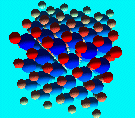
|
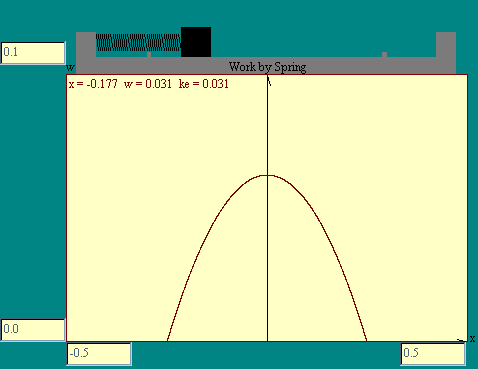
|
To get out of the mess implied in the preceding paragraph we
use a trick we have used before, even though I did not mention it
specifically at the time. When we talked about the
block and spring
apparatus we described a particle that was constrained by
the rails upon which it was sliding. Since it could not move in
any direction but plus and minus x, the number of equations
required to completely specify the motion was one.
By applying the constraint of the rails, we reduced the number
of equations needed to specify the motion. In general we will
look to use "constraints", physical properties of a
system that reduce the number of "degrees of freedom"
the system has. Degrees of freedom are the number of independent
variables required to completely specify the position of an
object. Each independent variable brings with it the need for an
equation of motion to specify the motion, so the application of
appropriate constraints can greatly simplify the arithmetic.
|
|
Getting back to our lump of iron with a zillion atoms in it.
If we had to treat each atom without constraint, we would have to
solve at least 3 zillion equations of motion. Fortunately under
the conditions we are interested in right now, iron is a solid.
In considering the motion of the lump as a whole, we may apply a
constraint that the distance between atoms is fixed. If that is
the case, how many degrees of freedom does a lump of iron have?
To answer that question we need to figure out how many
independent variables are required to specify its position. We
suspect that it will be less than three zillion, but is it just
three, as was the case for a single particle?
To help you visualize the situation, we
will begin with a very simple lump of iron with only two atoms in
it. We could specify its motion by independently specifying the
change of position of each of the two atoms with respect to time.
That would require six variables, an x, y and z for each atom. As
an alternative we could specify the position of one atom by x, y
and z, then fix the position of the other by giving a direction
and a distance from the first. But here is where the beauty of
the constraint comes in.
In predicting the future of this two-atom lump of iron, we are
only interested in parameters which may be different in the
future than they were in the past. Since the distance between the
atoms is constant, we may ignore the distance in specifying
changes in position. So I can completely specify the motion by a
set of five numbers, the x, y and z coordinates of one atom and
the distance of the other atom from any pair of axes. Run the
Two Atom Lump
display to see what I mean.
|
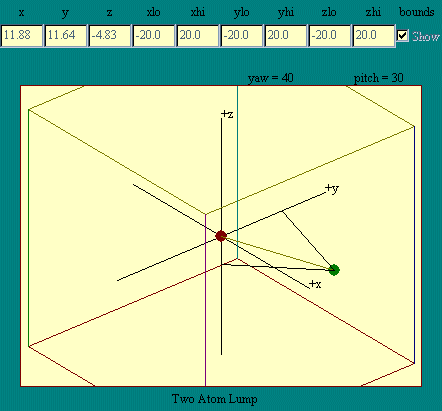
|
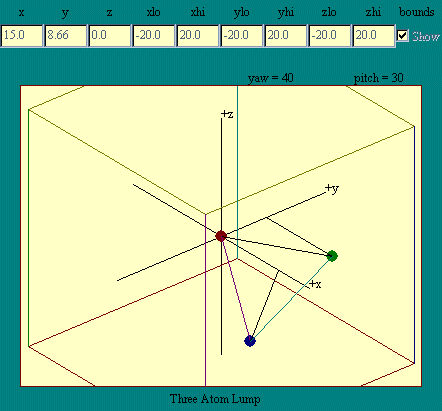
|
Now suppose I add a third atom to the
lump, having tied down two original atoms by specifying the five
numbers. Is it possible to have any motion of the system? If it
is, then the addition of the third atom introduced additional
freedom to the system. Run the Three Atom
Lump display to check this out.
Clearly the third atom is not locked in place by the five
numbers we specified to hold the two-atom lump fixed in space.
Another degree of freedom is evident. How many additional
coordinates are required to specify the position of the three
atom lump? Well the original five numbers fixed the position of
the two atoms and the line joining them. Since the distance of
the third atom from the other two is fixed, the only thing we
need to know in addition to the original numbers is the
orientation of the third atom around the line joining the first
two. In the absence of this information we could rotate the third
atom around the line joining the first two as shown in the
display.
Imagine fixing this orientation by specifying the distance
between the third atom and the axis not used in locking up the
position of the second atom. As you can see in the display,
fixing that would lock up the third atom so a three atom lump has
six degrees of freedom, requiring six numbers to specify its
position completely. Or in other words six constraints other than
the inherent fixed distance, "solid" constraint prevent
all motion.
|
|
How about a four-atom lump. The distance
of the fourth atom from each of the other three is fixed by the
solid constraint. In three dimensional space, as long as a
particle has three independent constraints, its position is
determined. The fourth atom gets three constraints from the solid
condition and the three other atoms. Run the
Four Atom Lump
display to help you picture this condition.
In the four-atom lump you have six constraints, the three
coordinates of the red atom at the origin and the three fixed
distances to the axes represented by the gray lines. There was
nothing special about the particular fourth atom we chose to
include so the position of any atom in the lump, even if there
are zillions, is determined by only six numbers. In other words
solid objects, otherwise unconstrained have six degrees of
freedom. So in the most general case we can specify the future of
any solid object with only six equations of motion. That is quite
a bargain considering the number of particle that make up most
solids.
|
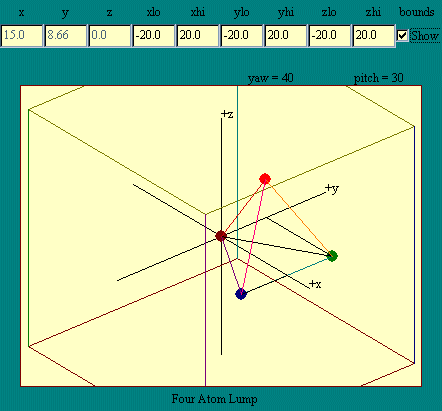
|
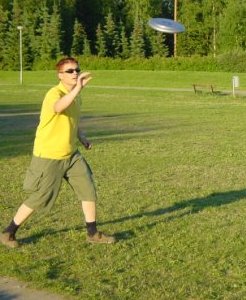
|
Still six equations might be hard to work with. We need some
way to organize them into manageable groups. Since we have
already done a lot of work with the motion of a particle,
wouldn't it be nice to be able to apply those ideas to
objects of finite extent? Well of course it would, otherwise I
would not have brought it up. So we shall proceed a ways in that
direction.
In looking at the degrees of freedom of our lumps, you may
have noticed that there were essentially two kinds of freedom.
One sort of freedom was freedom for the atoms to move all
together without changing their relative position to each other.
We will call that kind of motion "translational" motion
or translation. In translational motion each point in a body
experiences the same displacement as any other point as time goes
on, so that the motion of one particle represents the motion of
the whole body.
The other kind of freedom we saw in our iron lumps was the
freedom for the atoms to move relative to each other without the
whole lump partaking in the motion. In our examples so far this
sort of freedom involved rotation of one or more of the atoms.
There is another possibility for this sort of non-translational
motion if the solid constraint is somewhat less than solid so
that atoms may average some fixed distance from each other but
vibrate about this average position. This in fact is the nature
of solids if you look at fine enough detail. For now however we
will ignore the tiny vibrations of individual atoms and focus on
bulk motion of the object. The familiar airborne object in the image
at the left illustrates the two types of motion.
|
|
Even when an object vibrates
or rotates as it moves, there is point in the body, called the
"center of mass", that moves in the same way that a
single particle subject to the same external forces would move.
To get at this center of mass idea consider a two particle system
with masses m1 and m2 for the particles.
Let particle 1 be located at x1 on the x axis of our
reference frame and particle 2 be located at x2. The
center of mass is defined as a point
xcm = (m1 *
x1 + m2 * x2) / (m1 +
m2).
The center of mass lies on the line joining the two masses and
somewhere between them. If either m1 of m2
is zero, you can see that the center of mass just moves to the
location of the other particle. Run the
Two Particle Center of Mass
display for an illustration.
|
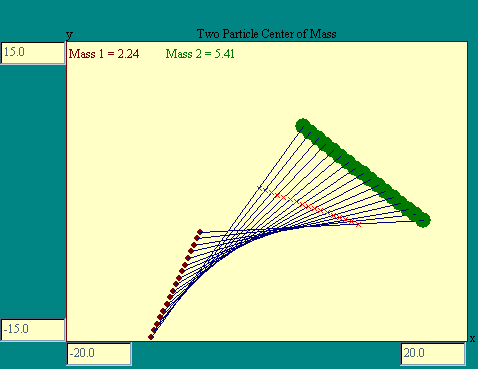
|
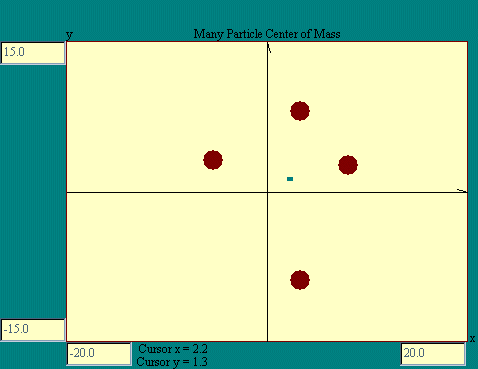
|
To extend this definition to more than two particles in a
straight line,
xcm = (m1 *
x1 + m2 * x2 +...+ mn
* xn) / (m1 + m2 +...+
mn).
In this formula n represents the number of particles and the
expressions in parentheses represents the summation of all the
terms 1 through n. To express this more compactly we could write
xcm =  mi*xi / mi*xi /  mi
mi
 I
know I said we would not get too mathematical and this looks like
unnecessary symbolism, but you will see this upper case Greek
letter sigma used this way in many places. The I
know I said we would not get too mathematical and this looks like
unnecessary symbolism, but you will see this upper case Greek
letter sigma used this way in many places. The  symbol is
interpreted to be the sum of all the terms which follow it where
the i in the first term is replaced by 1, in the second term by 2,
and so on until in the last term the i is replaced by the number
represented by n. The i in these expressions is called a
summation index. symbol is
interpreted to be the sum of all the terms which follow it where
the i in the first term is replaced by 1, in the second term by 2,
and so on until in the last term the i is replaced by the number
represented by n. The i in these expressions is called a
summation index.
The total mass m of all the particles is  mi so
m * xcm =
mi so
m * xcm =  mi * xi.
Now for a collection of particles not all in one line along the
x-axis we can define a center of mass in this way. The center of
mass is at (xcm, ycm, zcm) where
xcm = 1/m *
mi * xi.
Now for a collection of particles not all in one line along the
x-axis we can define a center of mass in this way. The center of
mass is at (xcm, ycm, zcm) where
xcm = 1/m *  mi * xi,
ycm = 1/m *
mi * xi,
ycm = 1/m *  mi * yi and finally,
zcm = 1/m *
mi * yi and finally,
zcm = 1/m *  mi * zi.
This may be a good point to remember that when we deal with
positions in space we may use either the coordinates x, y and z
or we may use a vector to designate a position. Rather than use
the generic v for vector, since we are dealing with a
position relative to the origin of our reference frame, we will
use the symbol r (for radius) as a position vector. In
vector notation the center of mass is at
rcm = 1/m *
mi * zi.
This may be a good point to remember that when we deal with
positions in space we may use either the coordinates x, y and z
or we may use a vector to designate a position. Rather than use
the generic v for vector, since we are dealing with a
position relative to the origin of our reference frame, we will
use the symbol r (for radius) as a position vector. In
vector notation the center of mass is at
rcm = 1/m *  mi * ri.
mi * ri.
To illustrate the center
of mass concept when the particles are not all in a straight line
run the
Many Particle Center of Mass
display.
Notice that there does not need to be any particle at the
center of mass, in fact the center of mass does not even have to
be inside a solid object. One way to judge the location of the
center of mass is to recognize that for solid objects it will be
the balance point. An object supported at its center of mass
would not tip one way or another. Try laying out the particles in
the display to try to find the center of mass of a fishhook
shaped object.
|
|
Now that we have the center of mass idea firmly in hand let's
look at the physical significance of the concept. Consider the
equation
m * rcm =
m1*r1 +
m2*r2...+
mn*rn.
 This equation holds true now and always.
You can find no instant in time when it is not true. Since this
is so, we know that the rate of change with respect to time of
the left side of our equation is equal to the rate of change with
respect to time of the right side. Let's use the ' symbol
to represent the rate of change with respect to time of a
quantity. For example r' is
Dr / Dt. For now
considering the mass m to be independent of time so we have
m * rcm' =
m1*r1' +
m2*r2'...+
mn*rn'.
The rate of change equation we just wrote is also true for all
time so we can set equal the rate of change of each side of this
equation as well so that
m * rcm'' =
m1*r1'' +
m2*r2''...+
mn*rn''
Remember that r'' is the acceleration of an
object located by the vector r, so the equation above
says that the total mass times the acceleration of the center of
mass is equal to the sum of each particle's mass times its
acceleration. The product of each particle's mass times its
acceleration, from Newton's second law, is the force acting
on that particle. So we arrive at the statement that the total
mass of a group of particles times the acceleration of the center
of mass is equal to the vector sum of all the forces acting on
the group of particles. So
m * rcm'' =
f1 + f2...+
fn.
Among all the forces acting on the particles will be the
internal forces the particles exert on one another. Newton's
third law, (remember the action and reaction story), says that
all these internal forces act in pairs, action and reaction, so
they cancel each other out in the vector sum. The net effect then
on the right side of the equation above is the sum of the
external or applied forces, fa. That brings
us to the relationship
m * rcm'' =
fa .
In words, the center of mass of a system of particles moves as
though all the mass were concentrated at that point and all the
external forces were applied at that point. This equation holds true now and always.
You can find no instant in time when it is not true. Since this
is so, we know that the rate of change with respect to time of
the left side of our equation is equal to the rate of change with
respect to time of the right side. Let's use the ' symbol
to represent the rate of change with respect to time of a
quantity. For example r' is
Dr / Dt. For now
considering the mass m to be independent of time so we have
m * rcm' =
m1*r1' +
m2*r2'...+
mn*rn'.
The rate of change equation we just wrote is also true for all
time so we can set equal the rate of change of each side of this
equation as well so that
m * rcm'' =
m1*r1'' +
m2*r2''...+
mn*rn''
Remember that r'' is the acceleration of an
object located by the vector r, so the equation above
says that the total mass times the acceleration of the center of
mass is equal to the sum of each particle's mass times its
acceleration. The product of each particle's mass times its
acceleration, from Newton's second law, is the force acting
on that particle. So we arrive at the statement that the total
mass of a group of particles times the acceleration of the center
of mass is equal to the vector sum of all the forces acting on
the group of particles. So
m * rcm'' =
f1 + f2...+
fn.
Among all the forces acting on the particles will be the
internal forces the particles exert on one another. Newton's
third law, (remember the action and reaction story), says that
all these internal forces act in pairs, action and reaction, so
they cancel each other out in the vector sum. The net effect then
on the right side of the equation above is the sum of the
external or applied forces, fa. That brings
us to the relationship
m * rcm'' =
fa .
In words, the center of mass of a system of particles moves as
though all the mass were concentrated at that point and all the
external forces were applied at that point.
We came to this understanding without saying anything specific
about the nature of the system of particles so our result applies
to rigid objects in which the particles are at fixed distances
from each other, but also any collection of particles even if
there is very complicated internal motion relative to the center
of mass. By introducing the center of mass idea, we got to the
fact that in systems of many particles, the center of mass moves
exactly like a single particle so we can adopt the whole set of
results already developed for one particle to describe the
translational motion of the whole system.
In the next lesson we will extend our understanding of
translational motion.

Are there any questions?
|

|

 Next
Next
 Previous
Previous
 Other
Other
|




